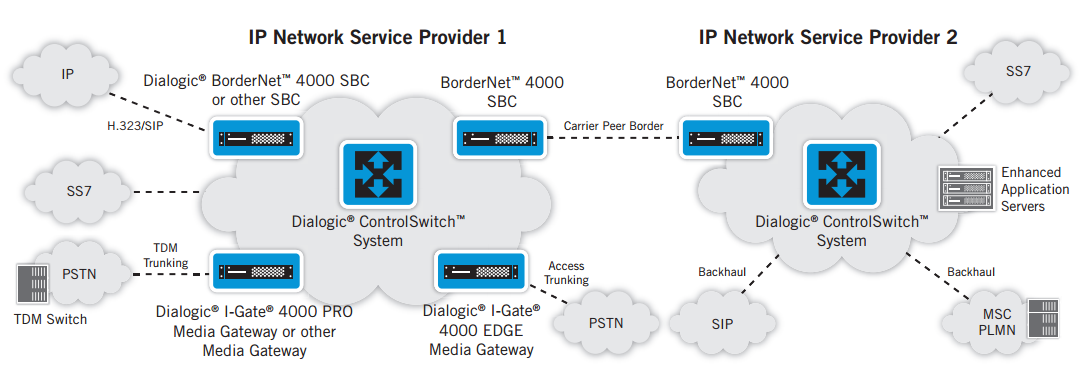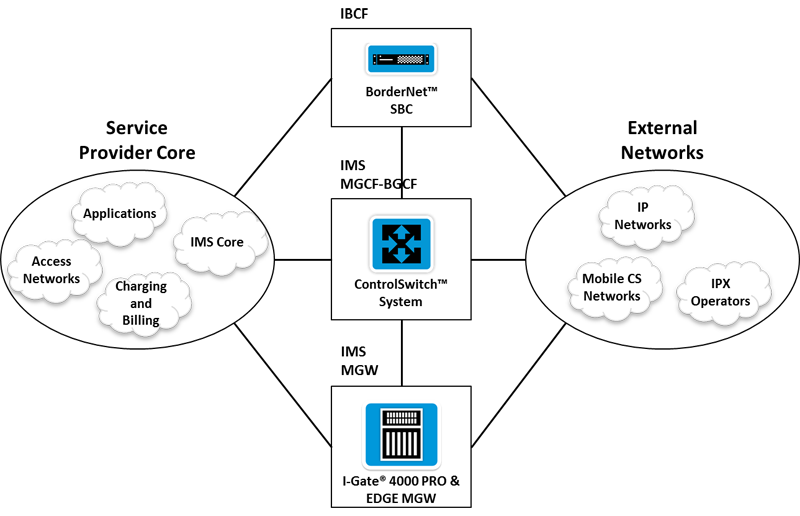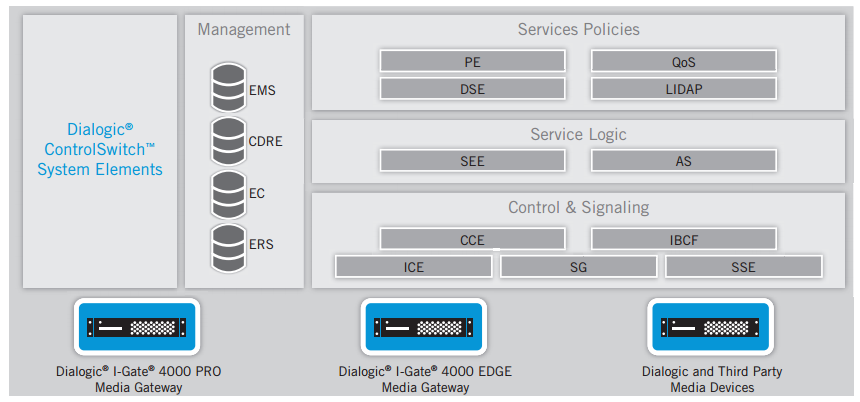Overview:
The Dialogic ControlSwitch System is an IP softswitch that provides a smooth migration path from existing TDM voice networks to the Next Generation Network/IP Multimedia Subsystem (NGN/ IMS) by enabling the interconnection of a mix of traditional and IP-based voice networks. The ControlSwitch System is built around an advanced modular, programmable, distributed, highly scalable, and high availability architecture with open interfaces to media devices, application servers, and back office systems.
The ControlSwitch System is designed for cost-effective scalability and configuration flexibility, with open interfaces and interoperability at all layers to allow service providers to create a comprehensive solution portfolio. The ControlSwitch System can smoothly integrate with a service provider’s existing back office and Operational Support (OS) Systems and includes built-in real-time service level assurance and revenue protection mechanisms.
Dialogic can show you how to gain your competitive edge and shed yourself of the limitations of your end-of-life TDM or softswitch technology. Transform your switching infrastructure into a powerful service delivery machine with the ControlSwitch System softswitch.
The ControlSwitch System is an open, carrier class platform that delivers the features service providers demand like
- Multi-protocol connectivity
- Distributed architecture and true geographic redundancy
- Centralized management and policy based routing
- Interoperability with other vendors’ media gateway platforms
- Extensive reporting and troubleshooting tools
- Cost-effective scalability without the need for a forklift upgrade
Combine the intelligent call control features of the ControlSwitch System with the industry leading I-Gate® 4000 PRO and EDGE Media Gateways and you can start taking advantage of significant bandwidth savings, in some cases up to 93%, as you modernize your global IP network.
Transform Your Legacy Switching Infrastructure
Service providers around the globe have deployed the ControlSwitch System to replace their aging and end-of-life legacy softswitch or TDM switching infrastructure. The ControlSwitch System Class 4 softswitch scales from a few thousand ports to networks with over one million ports expanding as your demand grows and eliminating the concern of having to undergo costly forklift upgrades like some other vendor approaches. And since it is an open softswitch solution, the ControlSwitch System is field proven to work with an array of other vendors' media gateways such as from Cisco or AudioCodes to help operators leverage their existing legacy investment.
The ControlSwitch System includes Diameter protocol support for charging and postpaid applications as well as support for CAMEL protocol based services such as mobile number portability. The operationally friendly platform makes it easier to centrally manage multiple ControlSwitch System instances across the globe and reduces the time and effort to update even the most complex routing tables. Reduced footprint configurations for the ControlSwitch System gives service providers with more modest initial traffic requirements, a future-ready, cost-effective, carrier-class switching platform with advanced features to help differentiate their VoIP offerings.
Service providers have the flexibility to architect their network with true geographic diversity. That means high availability and disaster recovery as well as increased operational efficiency since you can manage your Class 4 infrastructure as a single entity.
Moving to Packet-Based Technologies While Leveraging Circuit-Switched Voice Networks
Service providers face a complex set of challenges. Worldwide deregulation has increased the level of competition, forcing service providers to find new approaches to attract and retain profitable customers.
The new competitive environment and the rise of new modes of internet communication have reduced the profitability potential of the traditional Public Switched Telephone Network (PSTN). To compete, service providers must overcome the technical and financial hurdles of moving to increasingly efficient packet-based technologies and services while still leveraging existing circuit-switched voice networks.
In an environment replete with vendors offering proprietary vertical solutions, Dialogic provides open and interoperable solutions consistent with the intent of various standards bodies including the Third Generation Partnership Project (3GPP), Internet Engineering Task Force (IETF), International Telecommunication Union (ITU), and other proponents of distributed architecture principles and systems concepts.
Handling Packet Protocols
In order to maintain a competitive edge via reduced costs and increased service revenue, carriers around the world are looking to transition their current legacy voice services to Voice over Internet Protocol (VoIP). This migration calls for an innovative, open-standards packet-switched network that is flexible and can enable rapid deployment of new revenue generating services while reducing operating costs. The ControlSwitch System is well-suited to achieve this, and more.
The ability of the ControlSwitch System to mediate between various packet protocols (such as MGCP, H.323, SIP, and H.248) and global PSTN signaling protocols (SS7, PRI, CAS R1/R2) and variants gives service providers the flexibility to fully utilize existing resources and deliver a wide variety of enhanced services via any type of network. Additionally, the ControlSwitch System provides a cost effective migration strategy that leverages existing service investment and provides a clear path to an all-IP based IMS network.
A Multi-Tiered Reference Model with a Single Point of Management
The ControlSwitch System provides an unparalleled solution set for meeting the requirements of the next-generation multi-tiered reference model. The ControlSwitch System design allows for high scalability in granular increments — yielding an optimized solution for both initial and large-scale deployments. For instance, service providers can choose to centralize system management, billing subsystem, service logic, and routing, and distribute call control and signaling to various regional centers. In this way, an additional investment to support traffic growth is aligned with revenue growth without confronting scalability limits.
Regardless of the distribution of ControlSwitch System elements across multiple locations, Dialogic provides a single point of management for configuration, provisioning, and system monitoring, including real-time alarms, performance statistics, and traffic reports. In addition, the ControlSwitch System provides a single view of Call Detail Records (CDR) and provides end-to-end call tracing as an invaluable troubleshooting tool.
Various elements of the ControlSwitch System can be distributed geographically for scaling and redundancy — a primary element may be located in a city and can be backed up by the secondary element located in a different switching center even in a different city
Deployments:
Deploying New Services on a Single Platform
The open-standards, multi-protocol, multi-services ControlSwitch System platform enables new services to be implemented dynamically throughout the entire network - that is, service providers can deploy new services and solutions without the overhead of running multiple disparate networks or incurring downtime to reconfigure the network. Additional processing capacity is added using Common Off-the-Shelf (COTS) computing platforms.
For an illustration of a multi-service ControlSwitch System deployment example, see Figure 1.

Multi-Service Dialogic ControlSwitch System Deployment
Migrate to IMS/VoLTE With Confidence
Service providers needing best-in-class connectivity to both IP and TDM networks can deploy the ControlSwitch System to act as both the Media Gateway Control Function (MGCF) and Breakout Gateway Control Function (BGCF) in next generation IMS/VoLTE networks. I-Gate 4000 PRO and EDGE Media Gateways provide the bearer plane handling and BorderNet™ Session Border Controllers can be integrated operationally with the ControlSwitch System to provide IP-to-IP connectivity for Interconnection Border Control Function (IBCF) applications. The ControlSwitch System is part of Dialogic's comprehensive portfolio of IMS transformation solutions to help you take your network to the next level.

The ControlSwitch System provides operators with the best array of Class 4 softswitch connectivity options for their IMS/VoLTE networks.
Open and Flexible Solutions Designed to Meet Many Needs:
The ControlSwitch System has proven openness at all interface layers to enable service providers to rapidly interoperate with new vendors of media hardware and application servers. Additionally, the ControlSwitch System is a core element in solutions that incorporate products from Dialogic partners. Dialogic offers numerous field deployed solutions interoperable with specialized products from its partners. Therefore, service providers can quickly exchange traffic with other service providers and deploy services from Dialogic and its partners to help increase their revenue.
Real-Time Collection of Detailed Statistics
The ControlSwitch System incorporates the real-time collection of detailed statistics used for VoIP traffic prioritization and bandwidth utilization control. The network and application layer statistics collection system in combination with the Policy Engine enable advanced Quality of Service (QoS) Management and Service Level Agreements (SLAs) design. SLAs can be customized — per customer, per interconnection partner, per service, etc. The QoS element enables carriers — network-wide and in real time — to automatically obtain feedback and take corrective action to maintain custom SLAs.
Dashboard Functionality
The ControlSwitch element management system offers a dashboard into the service provider’s network. However, for service providers with a large investment in existing back office systems including provisioning, billing, and network operations, the ControlSwitch System offers many open interfaces including PL/SQL and XML for provisioning, SNMP for network management and text based CDRs for billing. ControlSwitch can also be deployed with back office traffic monitoring systems that require call status tracking in real time. Alternately, this application can also be used by operators wishing to record traffic patterns in real time.
Security Features
The ControlSwitch System provides security features to enable service providers to prevent malicious attacks on their network and fully protect their customers’ assets. These features include topology hiding to hide internal network and customer details, access control lists, and “denial of service” attack prevention, and far-end and near-end NAT traversal to avoid NAT/Firewall complications.
“Virtual Mesh” Tandem Switching
The market for mobile voice services is characterized by growth and constant churn in the customer base. To support this, wholesale network service providers and/or wireless service providers need to frequently add tandem switching and trunk capacity to connect new and existing Mobile Switching Centers (MSCs) and Gateway MSCs (G-MSCs) with each other. The investment by traditional TDM solutions to support this need is disproportionately high and is not realistically sustainable in a market with declining prices and margins. The ControlSwitch System provides a next-generation solution to this issue by delivering a highly efficient, distributed “virtual mesh” tandem switching solution, along with substantial bandwidth savings opportunities and toll quality voice over packet networks.
Service Broker Functionality
The ControlSwitch System delivers Service Broker functionality based on a unique and open architecture such as MSF and 3GPP. This provides a real-time transactional integration for significantly reduced integration cost, and it provides a bridge to web services. The architecture also enables: integration of best-of-breed service applications from multiple vendors; services scalability from 1-to-N application servers; service execution in a heterogeneous environment (that is, SIP, INAP); co-existence and quick delivery of services between legacy and next generation networks; delivery of new service business models and fast service customization without the burden and costs involved in forklift upgrades.
Helps Meet Specific Economic and Functional Requirements
Based on its open architecture, the ControlSwitch System provides ubiquitous, simultaneous multi-function capability across a broad range of applications. Because the call control and application elements of the ControlSwitch System are independent from the actual switching hardware, solutions deployment and implementation can be tailored according to a service provider’s specific economic and functional requirements. This represents a significant departure from traditional solutions that employ embedded control and applications software with limited flexibility.
The ControlSwitch System is a fundamental component of Dialogic’s IMS-compliant solution, which enables the coexistence of legacy and IP networks and flawless migration of service provider customers to a full IMS-NGN.
ControlSwitch System Elements
The ControlSwitch System is a multi-tiered, highly scalable, distributed software system that executes on commercial Oracle servers, interconnected over an underlying IP data network. A service provider can elect to start with a small system and grow it to a very large one, spanning multiple geographic centers, by adding components as the traffic and end-user volume increase. At a high level, the ControlSwitch System can be described as a distributed, IP network-based system providing traditional switch functions of call control, call routing, signaling gateway, and media device control in addition to back office functions in support of provisioning, billing, and network operations. The building blocks or elements of the ControlSwitch System are depicted in Figure 1.

Modular Reference Architecture
Element Descriptions
Element Management System (EMS)
The EMS provisions all ControlSwitch System components and enables the modular and distributed network solution to be easily managed from a single switch. It proactively monitors the status of the system’s elements. It provides call tracing, diagnostics, performance statistics, traffic reports, and browsing of call detail records stored in the CDR manager.
CDR Element (CDRE)
The CDRE is responsible for the ControlSwitch System billing and data analysis functions. It centralizes the billing data formatting and transport functions. The CDRE is responsible for generating one single billing record for one call.
Events Collector (EC)
The EC collects and stores billing and call-related events from the various ControlSwitch System elements for subsequent processing of reports and CDRs.
Event Relay Server (ERS)
The ERS enables the ControlSwitch System to integrate with the third-party Operational Support Systems (OSS) such as event monitoring applications and fraud management systems in a deployed ControlSwitch System network. It relays events in real time to the clients in an open and standard XML format for ease of integration with the customized event processing and monitoring applications.
Policy Element (PE)
The PE delivers unmatched flexibility, with policies that can be based on one hundred and sixty routable parameters. It responds to service policy queries with treatments based on a database of provisioned policies. It supports a growing variety of service policies including routing, screening, announcement, IN service triggers, QoS, registration, and authentication. Its customized policy creation and provisioning are GUIbased and a real-time in-memory hierarchical database enables an extremely high throughput.
Quality of Service (QoS) Server
The QoS Server provides a mechanism for feedback-based reporting and routing to assure service and guarantee SLAs. It monitors preestablished concurrent calls and imposes limitations based on Trunk Groups, Prefixes, Customer Interaction Center (CIC), and Telephone and Networking Services (TNS). In addition, it provides Answer-Seizure Ratio/Average Call Duration (ASR/ACD) based routing and reporting.
Directory Service Engine (DSE)
The DSE provides support for directory lookups and number translations natively via an optimized large directory query solution. For large directory applications such as Local Number Portability (LNP) or carrier ENUM, the DSE can scale up to 400 million entries.
Legal Intercept Data Access Point (LIDAP)
The LIDAP performs legal interception provisioning functionality. It communicates with a mediation device for the assignment of target information into a database and replies to queries from the Service Execution Element (SEE) to determine whether the call will be tagged for interception or not.
Service Execution Element (SEE)
The SEE allows for the rapid delivery of enhanced user services. Because it operates as a protocol-agnostic engine, the SEE enables service creation, regardless of the underlying framework. The SEE executes the service logic within the ControlSwitch System and can serve as a service broker when coordination is required across multiple external application platforms. Flexible adapters enable SEE services to combine resources residing in ControlSwitch System elements as well as external application systems such as Intelligent Network (IN) systems and SIP-based application servers. Rapid services creation, deployment, and activation are enabled via XML scripting. SEE is based on the Services Logic Execution Environment (SLEE) and is developed in C++. Some of the services provided are announcements, postpaid, account codes, toll free, collect call, IVR services, and IN services.
Application Server (AS)
Value-added services can be implemented easily and quickly via third-party application servers or natively via the ControlSwitch System SEE. Value-added services (such as calling cards [prepaid/postpaid/travel], conferencing, call center, messaging, VoIP VPN, account codes, premium number with IVR, call block, collect call) are in-service today on the ControlSwitch System.
Call Control Element (CCE)
The CCE supports protocol-specific call control and protocol mediation between PSTN facing (SS7/C7, ISDN-PRI, CAS) and generic call processing protocols and resource management (Trunk Gateways [TGs], channels, Gateways [GWs]) using MGCP/H.248.
Interconnect Border Control Function (IBCF)
The IBCF enables global carrier IP peering, protects the carrier network against malicious attacks, and provides key security features including topology hiding, access control lists for “denial of service” attack prevention, and far-end and near-end Network Address Translation (NAT) traversal to avoid NAT/firewall complications.
IP Call Element (ICE)
T
he ICE supports SIP and H.323 protocol-specific processing, protocol mediation between VoIP protocols (SIP and H.323), ControlSwitch System generic call processing protocols, resource management (IP Trunk Groups, IP Gateways, Gatekeepers), and SIP-I and SIP-T protocols.
Distributed Signaling Gateway (DSG)
The DSG, built on the Dialogic I-Gate 4000 EDGE Media Gateway, allows the ControlSwitch System to connect to the SSP, STP, and SCP resources of the SS7/C7 network for PSTN call signaling and for intelligent networking services.
SIGTRAN Signaling Element (SSE)
The SSE supports MTP level 3 User Adaptation (M3UA) that is defined within the SIGTRAN protocol suite. It uses the Stream Control Transport Protocol (SCTP) and Internet Protocol (IP) as its underlying transport, enables service providers to take advantage of the IP transport network, and offers additional features.
![]()